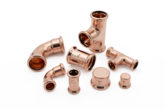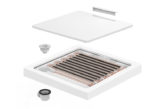
Ken Vance, Training Manager at Salamander Pumps, explains all you need to know about mains boosting, and how you can improve a home’s water performance.
Low water pressure and flow is a common problem that many people across the UK have experienced. However, almost half of homeowners (48%) are unaware that it is possible to improve water pressure and flow in a home, according to a recent study by Salamander Pumps.
In fact, boosting the flow and pressure from a home’s incoming mains supply can drastically improve the performance of taps, showers, baths, and many other outlets in the house. However, it seems that there is often a misconception around mains boosting, with some installers believing this to be illegal, under the Water Supply and Fittings Regulations of 1999.
Low pressure
Low water pressure in a home can be caused by a variety of factors – from a home’s plumbing system to the time of day. For houses with mains fed combi boilers or an unvented cylinder it’s very common for water pressure to fluctuate during the day.
In peak times before and after work, often the whole street will see a drop in water pressure as the demand from residents increases. The pressure will then increase again during the day and especially overnight, while most residents are out and there is less demand.
Thankfully, for homes with a mains-fed system suffering from low water pressure, it’s possible to boost the mains water, in line with the Water Supply and Fittings Regulations of 1999, to increase flow and pressure across the whole house.
The regs
While there is a general misconception that the Water Supply and Fittings Regulations of 1999 prevent you from fitting a pump directly to mains water, there is actually an effective way to improve water pressure and flow in the home, in line with these guidelines.
Government regulations state that pumped mains water must not exceed 12 litres per minute (l/min), however, many households are experiencing a flow much lower than this, or need more than 12 litres per minute. This means that homes are able to boost their incoming mains water, as long as the pumped water flow does not exceed this limit. Alternatively, homes that require increased flow beyond these limits can install water storage solutions, which can provide flow and pressure far greater than 12l/min, whilst still conforming to the guidelines.
Boosting up to 12l/min
There are products available on the market that allow a home to increase its water pressure and flow to up to 12l/min. One of these is Salamander Pumps’ intelligent, WRAS approved, inline pump, HomeBoost, which is attached directly to the home’s existing mains water supply and works by monitoring the water flow through the pump, only kicking into action when needed. Where the pumps recognises the flow is less than 12 l/min it will boost the water flow up to 12 l/min, however if the flow naturally rises above this it will enter a standby mode, not assisting or restricting the flow, meaning it fully complies with the regulations.
Alternatively, Salamander has also recently introduced another inline pump, CombiBoost, which is designed to boost mains flow to up to 10l/min. This pump is again fitted directly onto the incoming mains supply, and is more suitable for smaller households and combi boilers which are looking to improve their water performance.
Inline pumps are compact and easy to install either after the stop tap or just before a combi boiler. Both options are in keeping with Water Supply and Fittings Regulations of 1999.
Boosting beyond 12l/min
For larger homes, multiple bathrooms and larger installations with a greater water demand, 12l/min may not be sufficient to run multiple showers and outlets simultaneously. In these situations, a greater flow and pressure across the home is needed, meaning homes will need to store water at pressure, so as to remain in accordance with the water regulations.
To achieve this, a home can have an accumulator tank installed to provide flow of up to 36l/min. Salamander’s new range of accumulator tanks, AccuBoost, consists of 9 different models, ranging from 60 litres to 450 litres and including pumped and unpumped tanks, to provide a solution to boosting mains water when higher flow rates are required, over and above what the mains water is currently supplying.
Factors to consider
Pumped or unpumped? Accumulator tanks are available as both pumped and unpumped models, depending on the home’s existing water supply. You should install a pumped tank if the home’s water pressure is less than 2.0 bar, the water flow is less than 12l/min, or the highest outlet is on the second floor or higher.
Combi or unvented? It’s important to consider the heating system of a home when specifying a suitable accumulator tank. While all options are suitable for a combi boiler, a home with an unvented system would require a minimum of 300 or 400 litres capacity, possibly more.
How many outlets do you want to run at once? To specify which size tank a home needs, it’s important to calculate the flow rate per minute of the outlets you want to run at any one time. As a rough guide, a tap would have an estimated flow rate of 8l/min, an electric shower of 9l/min, standard showerhead of 12l/min, a large showerhead or bath would be 15l/min, and a drench showerhead would be 25l/min.
Once you have calculated this, you can then identify which size accumulator tank will provide this flow rate for a minimum of 9 minutes – the average length of a shower.
As a rough rule of thumb, a pumped 60L tank can provide flow of up to 14l/min, a pumped 120L tank can provide up to 16l/min, a pumped 180L tank can provide up to 18l/min, a pumped 300L tank can provide up to 30l/min, and a pumped 450L tank can provide up to 36l/min.
How much space do you have available? If space is limited, you may need to choose a smaller model, which would mean running fewer outlets simultaneously. A 60L model will fit into a standard 500mm standard kitchen base unit. A 120L model will fit into a 500mm larder style kitchen unit and the 180L/300L model will fit into a 600mm larder style kitchen unit with the back removed although other locations are suitable.
If AccuBoost models are stored within a unit, the base of the unit should be reinforced to withstand the maximum filled weight of the product, or the base should be removed and the AccuBoost mounted on the floor.













